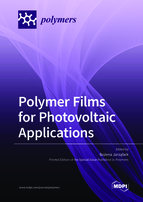Polymer Films for Photovoltaic Applications
A special issue of Polymers (ISSN 2073-4360). This special issue belongs to the section "Polymer Membranes and Films".
Deadline for manuscript submissions: closed (30 April 2022) | Viewed by 49052
Special Issue Editor
Interests: organic materials and conjugated polymers; thin films and nanotechnology; materials characterization; optical spectroscopy; absorption edge parameters; electronic transitions; thermo-optical properties; doping; polymer films in optoelectronic structures
Special Issues, Collections and Topics in MDPI journals
Special Issue Information
Dear Colleagues,
This Special Issue focuses on the polymer thin films and polymer blend films in photovoltaic (PV) structures. Organic materials are widely used today in optoelectronic devices, such as organic solar cells (OSCs), mainly due to the low cost of production (thin films may be deposited at low temperature on a large surface, on flexible substrates). However, polymer compounds in OSC systems also have certain limitations, such as low efficiency and short lifetime of devices, resulting from an insufficient thermal and time stability. Polymers, which may be utilized in PV systems, should exhibit the appropriate optical properties (e.g., a wide range of absorption and low energy gap), good durability and stability (not undergoing any phase transitions or degradation in the temperature range in which the system is working), and relevant electronic structure (good alignment of molecular orbitals of donor and acceptor compounds in bulk heterojunction (BHJ) organic solar cells).
This Special Issue covers all the fields related to polymer films for photovoltaic applications, but special attention will be given to the following aspects:
- Synthesis and suitable modification of polymer structure, to obtain polymer thin films for PV devices;
- Influence of film deposition (TVE—thermal vacuum evaporation, CVD—chemical vapor deposition, spin coating, spray, etc.) on properties of polymer films;
- Thermo-optical properties of polymer thin films and blends of polymer films, as potential parts of PV systems;
- Influence of doping or protonation of polymer thin films and blend polymer films on their properties;
- Polymer thin films, as active layers in PV solar cells—correlation of chemical structure and PV properties;
- BHJ solar cells with polymer blends films—the choice of blend film composition to obtain the best PV parameters.
Authors are welcome to submit their latest research in the form of original full articles, communications, or reviews on this topic.
Prof. Dr. Bożena Jarząbek
Guest Editor
Manuscript Submission Information
Manuscripts should be submitted online at www.mdpi.com by registering and logging in to this website. Once you are registered, click here to go to the submission form. Manuscripts can be submitted until the deadline. All submissions that pass pre-check are peer-reviewed. Accepted papers will be published continuously in the journal (as soon as accepted) and will be listed together on the special issue website. Research articles, review articles as well as short communications are invited. For planned papers, a title and short abstract (about 100 words) can be sent to the Editorial Office for announcement on this website.
Submitted manuscripts should not have been published previously, nor be under consideration for publication elsewhere (except conference proceedings papers). All manuscripts are thoroughly refereed through a single-blind peer-review process. A guide for authors and other relevant information for submission of manuscripts is available on the Instructions for Authors page. Polymers is an international peer-reviewed open access semimonthly journal published by MDPI.
Please visit the Instructions for Authors page before submitting a manuscript. The Article Processing Charge (APC) for publication in this open access journal is 2700 CHF (Swiss Francs). Submitted papers should be well formatted and use good English. Authors may use MDPI's English editing service prior to publication or during author revisions.
Keywords
- polymer thin films
- polymer blends films
- doped polymer films
- thermo-optical properties
- organic solar cells
- BHJ photovoltaic structures







